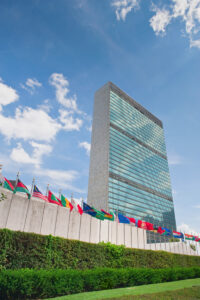
Trouble at the UN?
Last week, the United States butted heads with Russia and China at the United Nations Security Council. The reason? A disagreement over the Council’s policies toward North Korea.

A week earlier, the United States submitted a complaint to the Security Council, saying that North Korea had imported more than three times its permitted amount of refined petroleum–nearly 1.4 million barrels–so far in 2018. According to the complaint, North Korea smuggled petroleum illegally between ships while at sea–at least 89 times. The U.S. then suggested that the Security Council demand that any additional North Korean refined petroleum imports be stopped immediately.
Other U.N. member nations had until last week to challenge the U.S.’s claims. At the last minute, Russia and China put a “hold” on the complaint. This means that the Security Council can’t take any action for six months.
The United States responded by warning that not enforcing sanctions against North Korea could be dangerous. U.S. Secretary of State Mike Pompeo, and U.S. Ambassador to the United Nations Nikki Haley, issued a statement that North Korean leader Kim Jong Un needs to make good on his promise to denuclearize–a position which the United Nations fully supports. China and Russia defended their challenge, however, saying that although they agree that North Korea must denuclearize, they have questions about the specifics of the U.S.’s latest accusations.
Dig Deeper What is refined petroleum used for? Based on what you know about the relationship between North Korea and the United States, why do you think the U.S. would be opposed to North Korea importing refined petroleum?
New Elections, Old Fears?
These days, it would be difficult to find someone in the United States who isn’t aware that Russia tampered with the 2016 presidential election. Two years later, the question becomes not whether or not Russia did it, but whether or not they will do it again in 2018.
Despite Trump’s waffling on the issue, special counsel Robert Mueller has recently indicted twelve Russian intelligence officers for hacking into state election computer networks. And a recent statement from Homeland Security Secretary Kirstjen Nielson indicated that it’s a safe assumption that Russia will try to do it again. Other lawmakers, both Democrats and Republicans, agree.
So what can we do to stop them? Congress has now released $380 million to state and local election authorities to help them shore up their cybersecurity–though many are concerned that this amount of money is too little, too late. However, a bill with bipartisan support is making its way slowly through Congress that would require election boards to take additional security measures, such as a post-election audit of results.
One big advantage we have is that our election system is decentralized: in other words, anyone tampering with elections must do so state by state. Also, now that we are aware of what happened in 2016, state and local officials are more prepared to identify another cyberattack.
The bad news is that, whether or not Russia (or another entity) actually tampers with the 2018 elections, the fact that it already happened once has weakened many Americans’ faith in the voting process. This loss of faith in voting–the fundamental process of democracy–is a blow from which it will likely take much more than money or legislation to recover.
What Do You Think? Based on what you’ve read here and seen in the news, write a letter to the editor of your local paper in which you explain why, now more than ever, it’s important for everyone to vote in the 2018 midterm elections.
D.C. Counts Cats
Everyone loves cats, right?
Wrong.
Cats, particularly stray cats, are–along with other mammalian predators such as rats and foxes–becoming a major problem in several U.S. cities. There are possibly millions of stray and feral cats in Los Angeles, and tens of thousands in New York City. Why are stray cats such a problem? First, they sometimes carry rabies or other diseases that can spread to humans. But experts also say that they are responsible for the deaths of more than two billion birds each year in the United States alone. They also kill lizards and other small native creatures. In fact, it is estimated that cats have been at least partially responsible for the extinction of 63 animal species. And if that’s not bad enough, their waste can pollute waterways.
In response, Washington D.C. is embarking on a massive undertaking: to count every single cat living in the city, strays and pets alike. The $1.5 million, three-year-long program, called D.C. Cat Count, will study cat populations through 60 outdoor cameras, as well as an app that allows people to upload photos of the cats they see. No city has ever before attempted to count every single cat that lives within its borders. It’s an especially difficult project when one considers how secretive cats are, and how they like to hide. But authorities argue that the investment is important. Before the city can figure out policies to deal with the cat population, they need to know exactly how many cats they are dealing with in the first place.
Dig Deeper The United States is not the only country struggling to figure out what to do about its stray cat population. Read the following article to learn about feral cats in Australia. Write a short paragraph about what you learn.
Baby Trump to Visit New Jersey
Recently, in honor of Trump’s UK tour, the citizens of London flew a giant balloon over their city. You might think that this meant they were celebrating Trump’s arrival, but actually, the opposite was true. The blimp–nicknamed “Baby Trump”–was a twenty-foot tall, inflated portrayal of the president carrying a phone, crying, and wearing a diaper. The blimp received worldwide attention, and now, activists are planning to create a second one, this time here in the United States.
Didier Jiminez-Castro and Jim Girvan live in New Jersey and are spearheading the movement to bring Baby Trump stateside. Their plan is to fly the new balloon, which should be ready by next month, near the National Golf Club in Bedminster, New Jersey, where Trump frequently plays golf. To fund the new balloon, the pair started a GoFundMe page, setting a goal of $4,500. In a matter of days, the page vastly exceeded their goal, raising nearly $24,000.
However, not everyone agrees with the Baby Trump mission. Another New Jersey resident, Kathie Kitt Conklin, learned about the activists’ plan and decided to start her own GoFundMe page to cover legal expenses if she is arrested for deflating the blimp. She’d hoped for $1,000, but raised only $285 before the page was shut down.
During Trump’s UK tour, he stated that he knew about the blimp and that it made him feel unwelcome in London. Therefore, he only spent a single night in the city. It remains to be seen what impact a second balloon right outside his favorite club will have on his golf game.
